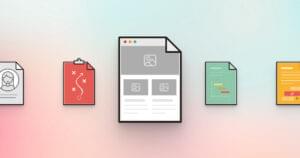When you’re developing a business idea it can be tempting to build the product as quickly as possible in order to launch it early. Often, this is a fatal mistake because it can result in building a solution to your problem rather than something the users will value.
Although market research might seem like a boring and daunting task, it is still a vital component of any software development project. I’m going to run you through the basics of conducting user interviews so that you can avoid crashing and burning and understand the power that they have. While there are many ways to get feedback from your users, this article is focused on getting thorough insights through user interviews that will actually give you information that you can use.
Proper Preparation

Conducting user interviews isn’t just a matter of asking questions and jotting down the answers. For an interview to be effective you’ll have to put effort into your preparation. You’ll need to ensure that your questions cover the following areas:
-
Who: Identify the demographic your product is targeting and tailor your questions to that group. Ask yourself, “Who is my ideal customer for this offering?”
-
What: What are the problems you intend to solve? The best way to frame this is to think: “What are the biggest pain points my potential users are experiencing?”
-
When: As you draft your interview, keep in mind the times users will use your product or service. This is best covered by asking yourself, “is this something essential to a users life, or is it something they’ll only use once in a while.”
-
Where: To further help with identifying context, you’ll need to consider where the product or service is used. For example, users on a mobile device will have a shorter attention span than those on a desktop device. There are many potential answers to this question, but in general you’ll want to focus on whether the product is for work or recreation and whether the user will be on the go or at their desk.
-
Why: Understanding the psychology of customers is crucial since it’s difficult to change existing behavior. Dozens of companies offer email, but there are plenty of unique aspects that make them appeal to different audiences. Ask your potential users, “What are the biggest reasons you use product X?”
-
How: Consider how users commonly perform tasks already. Although you can’t really address this without in-depth analytics such as session tracking and more. Having a handle on this is vital to identifying ways to improve the users experience. This isn’t something you can address by asking specific questions. You just need to observe how users interact with different offerings.
During the Interview
Reading the interviewee
It’s usually best to talk with users in their natural surroundings however this is one of the most expensive methods of conducting an interview. The next best step is to use conferencing software or video chats to conduct your interviews, unless of course the interviewee can come to your office. The reason for this is that facial cues and body language are crucial to understanding the true feelings of interviewee. There are a lot of techniques out there for reading visual facial clues and body language but don’t worry about these too much. Following your gut feeling will be enough to understand what your subject is really saying.
Don’t be too formal
Although you should have some structure to your interview, you don’t want it to be like an interrogation. You’ll want to open the interview by building trust with the participant. Explain the purpose of the interview and how the results will be used. Also ask if the participant has any questions themselves.
When you begin the interview, follow the format of an inverted pyramid. Start off with general questions and save the detailed questions for when the conversation is started. If you develop a good rapport with the participant, the interview is more likely to uncover information from unanticipated areas. You’ll always want the participant to lead the conversation because of this aspect.
Focus on pain points
Although your interview questions will vary based on the nature of your offering, you’ll want to focus heavily around the participants pain points. Even if your product helps to solve a problem faced by your customers, you’ll need to ensure that those customers are willing to pay for the solution. If you can’t convince someone to pay a decent fee for your offering, then that’s a sign that you should focus on a different market.
Have a teammate listen in or observe
Having a second set of eyes help with analyzing the interview is vital to the success of your interviews since they can catch additional information you would overlook while interacting with participants. Ideally you’ll want to have the observer stay behind the scenes so participants aren’t intimidated, however this isn’t always possible.
Interview Limitations
Although user interviews can be an efficient way to gather essential information to improve your products, you should keep the following in mind before moving forward:
-
When conducing an interview, remember that answers to your questions are based on guesses around how a customer thinks they’ll use a product. To see how users actually interact with your offering, you’ll have to use direct usability analysis on your prototypes.
-
Direct user interviews can be costly and due to the time commitment, you’re often limited to a small sample size.
-
As Steve Jobs once said, “A lot of times, people don’t know what they want until you show it to them.” This is why you should build your prototypes with Lean Principles so you can test innovative ideas, while incorporating user feedback to tune them.
After the Interview
Once you’ve interviewed your users, you’ll need to translate the data you’ve gathered into actionable information for your developers. Before handing the data over, you will need to perform triage on user requests to ensure you focus on the features with the most return on investment. By incorporating feedback in stages, you can ensure that it’s easy to roll back changes that don’t work.
Conclusion
It’s important to realize that user interviews should be used alongside usability testing, competitive analysis, polling and more so you can get a more holistic view of your company.
Even though user interviews can seem daunting they are vital as interviews allow you to get inside the minds of your users. It also is a fairly simple concept which is fairly simple in its most basic form involves having conversations with your customers.
Without user feedback, your development team is essentially guessing at what will and what won’t be a success in the market. In today’s competitive world, any form of lost time can spell disaster for even the best-tuned teams.
 Charles Costa
Charles CostaCharles Costa is a content strategist and product marketer based out of Silicon Valley. Feel free to learn more at CharlesCosta.net.





